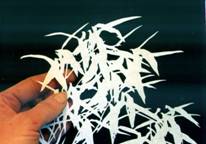 Photo 1: White Bamboo
Photo 1: White Bamboo
This is a small white papercut from tissue thin mulberry or hosho paper, I purchased in Chinatown, San Francisco about 20 years ago for $2.00. Still in good shape after years of handling during teaching classes.
Papercuts...no pun intended. I am not speaking of the painful sliced finger by a freshly bevel cut window mat. But alas, the beautiful folk art that has existed for centuries around the world. The intricacies and delicate nature of these beautiful artworks have been both a joy to view, a source of history, and enjoyable pastime, and a bane of many a custom framer.
Papercutting is a craft or folk art involving a design that has been laid out with the perfect balance of positive and negative space to allow for artistic delicacy and openness while still holding together after being cut. The basic materials required are a piece of thin paper and a cutting tool, either scissors or a blade. Even with these simple basic elements this craft has developed into a highly popular art form which is often brought back from trips to Europe and Asia, as well as being practiced here in the States. Papercutting is done using very thin delicate sheets, sometimes layered in multiple colors, sometimes single sheets, is a time intensive skill, and requires much care when handling (photo 1).
 Photo 1: White Bamboo
Photo 1: White Bamboo
This is a small white papercut from tissue thin mulberry or hosho paper, I purchased in Chinatown, San Francisco about 20 years ago for $2.00. Still in good shape after years of handling during teaching classes.
History of Chinese Paper Cutting
Papercutting is one of the oldest and most enduring art activities in China, known as chien chih. The earliest samples come from the Han dynasty (206 B.C. to A.D. 220), when gold and silver foils were used instead of paper. Papercutting is a folk art in China, with numerous regional differences. Prior to the development of transportation and communications many areas were isolated from one another. People relied on their own resources to decorate their homes, and relate history and folk traditions (photo 2). Cutting techniques have remained somewhat constant for centuries.
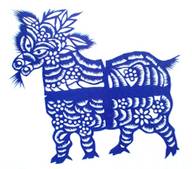 Photo 2: Blue Sheep
Photo 2: Blue Sheep
A single color example from Shaanxi province. Since this piece was used for pasting into a window the white cutaway space is rather large to allow ore light through.
Papercuts were used not only to decorate walls, windows and lanterns, but also to depict images of what families hope for in life and death. Cutouts were used to decorate and to tell stories. One of the most important annual events in a Chinese family is the celebration of the New Year. People want to placate the gods and ensure good health and continued prosperity, so cuttings were often pasted up in every available location in a home where help might be needed. Much including the concept of Feng Shui.
Shaanxi Province of Central China
The images from the Shaanxi province of central China were single color and often illustrated subjects connected to everyday life (photo 2). Farmers needed strong sheep and the strength came out of the forceful paper cutting techniques, while still maintaining the imagination for creative interpretations of stylized hair, leaves for ears, and a total lack of three dimensionality.
The red family (photo 3) was designed for wall decoration and features a more organic interpretation of the natural growth of children from the root of their parents and the interconnection of all nature.
 Photo 3: Red Family
Photo 3: Red Family
This image shows the concept of the ideal family , two sons and a daughter, and is designed to be used on a wall. The daughter is in the middle, perhaps still unborn, while the boys grow like apples from either side of the parental tree.
Hebei Province of Northeast China
In northeastern China the Hebei province style of papercutting was very different. Vivid colors and multiple layers were used to depict stories, and these images were often used in windows. I'd like to note the papers used were, and continue to be, metallic foils as well as thin dyed papers. They can be light fugitive which leads to believe these images though very time intensive were most likely replaced often. Particularly the ones placed in sunny windows.
Consider for a moment the amount of time it takes the sun to discolor tissue paper. I can only be assumed papercutting was an enjoyable pastime and that these images were frequently replaced. Also realize when framing one of these treasures that it is most likely the visible light that gives the paper its color, that fades it more than the UV rays. This said, coated and UV glazing may not deter fading as we might hope.
The brightly colored and detailed papercut of goldfish and lotus in photo 4, is a wish fulfillment symbol hoping for fertility in a new marriage. Again it is cut with much openness so it will allow the sunlight to flood in through the windows.
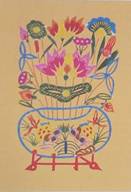 Photo 4: Fish Bowl and Lotus
Photo 4: Fish Bowl and Lotus
This window papercut of fish and lotus is a wish fulfillment symbol hoping for fertility in a new marriage.
Some papercuts show and tell stories that have been passed down for generations. As mentioned earlier, during the early days when communications were limited, history was recorded in this way. Only scholars could read or write so these became the traditional methods for recording and passing on history to new generations and travelers.
In this ancient story (photo 5) when passers by saw the old man fishing from a rock they wondered why he held his rod three feet above the water. He said it was to attract the attention of the emperor when he came to visit. His ploy was successful, and he was made prime minister.
 Photo 5: Fisherman
Photo 5: Fisherman
This is an ancient story passed down through generations about an old man fishing from a rock to attract the attention of the emperor. Notice the delicacy and threading of the water creation.
Papercutting Around the Globe
China was not the only country that boasts of the ancient tradition of papercutting. In Japan papercutting is called monkiri, and the stories are the same as in China. As I mentioned in my article on Scrolls (PFM April and May 2001) the houses in Japan are often constructed with very thin walls incapable of supporting a great deal of weight. Papercutting produced decorative lightweight colorful possibilities for decoration.
In Germany and Switzerland the art is known as scherenschnitte. The large intricate patterns of scherenschnitte I have admired involved hundreds of hours of detailed cutting with tiny scissors. In Poland it is called wycinanki, and The Dutch call it knippen. Many, many cultures have embraced this traditional form in one way or another. In Jewish cultures it is part of their religious artwork and holiday celebrations. And I remember learning how to cut snowflakes from folded paper back in kindergarten, a very long time ago.
Time Consuming Craft
When in China I had the pleasure of experiencing numerous craftspeople working. Some may have been worker bees given patterns to copy or images to trace, but nonetheless the craft continues. Though it may be true that many Asian papercuts target the tourist trade, are very inexpensive and most likely are mass produced by machine, the fact that there are artisans continuing to show the old methods and traditions keeps these types of fine art crafts in the forefront.
The young man in photo 6 is papercutting using the traditional methods of placing a pattern on top of the colored paper then cutting through both to achieve the design. It takes him three days to execute this particular design of 'prosperity.' He was photographed in a shop in Shanghai that sold both framed and unframed papercut images from 5"x7" to 20"x30". Most were produced in solid single primary layer colors of red, blue, yellow and black. There were also gold and silver images. The most popular were the size in the photo about 11"x14" which sold for approximately $18.00 USD. All for three days work.
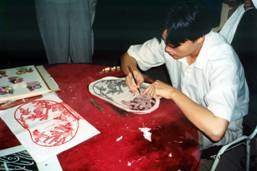 Photo 6: Papercutting Demonstration
Photo 6: Papercutting Demonstration
This young man will work for three days on this papercut bowl of goldfish. Fish are the symbol of prosperity, the gold color of live fish stands for money.
In the close up detail (photo 7) notice the pattern is stapled to the red under papercut and that he is cutting with a sharp pointed knife much like a #11 Xacto™ knife.By the way, framed pieces were pressed against the glass in a narrow unmatted frame and sold for around $25USD.
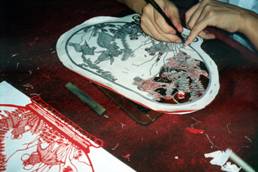 Photo 7: Detail of Hand Cutting
Photo 7: Detail of Hand Cutting
Notice the pattern overlay on top of the red paper beneath. He cuts using a straight edged knife commonly found anywhere in the world.
Mounting Options
In the United States, the thing we must keep in mind about these small fragile treasures is that although they may not cost much they may hold a great deal of sentimental or family value and will require proper care when framing. True that the papers used to create them may not be archival, neutral pH, or 100% cotton, but like any other heirloom or collectible they must be framed so that nothing we do becomes invasive to the preservation of the papercutting itself.
While in China last summer these little craft items were seen everywhere. They were sold packaged for tourists most likely bulk cut with lasers in order to mass produce them at a price of 4-6 pieces of 5"x7" images often multi-layered in colors for as little as $5.00 USD. Not an expensive investment in Asian artistry but a keepsake reminiscent of a $5,000. trip to the Orient one summer.
Right or Wrong
In my book, The Mounting and Laminating Handbook, I discussed two options for mounting these delicate images. The first being a time intensive wet glue approach and the second being spray adhesive. True, the spray is not a preservation approach to mounting, but it is a nonreversible choice. Since the publishing of my first edition in 1997, I have embraced improved applications and given way to the more desirable noninvasive method of encapsulation using Mylar-D.
I am not going to stress the right or wrong approach to mounting, I will only give the basic information and outcome, the judgment call will forever remain up to each individual framer and their client.
Spray Application
Delicate problem mountings may be well suited to spray mounting techniques. The intricacies of papercuts with their multiple openings makes basic traditional wet, pressure-sensitive and dry mounting techniques all rather unacceptable due to adhesive being visible between the cutouts and the added potential of artwork damage.
It is not possible to spray directly onto the papercut art. Because of its delicate nature and the thinness of the papers they could become damaged. Great care needs to be taken when applying spray so not to puddle it or run it under the cuts to the front of the art. It is therefore best to mist the spray adhesive from above, letting it gently settle onto the back of the art, which has been supported by an accordion folded piece of rigid paper stock to keep the art out of the adhesive. Be very careful when handling this type of artwork, and respect its delicate nature at all times. It is so fragile that even the draw of a cold vacuum frame or the clamped closing of a mechanical press can tear the tiny sections.
Size and prepare materials. Select a spray that will reactivate and mount with the application of heat, such as Vac-U-Mount™., Good Glue Spray™. or Sure Mount Spray™. Lay the papercut face down onto an accordion folded support with the accordion folds small enough to support all loose cutout portions of the art. A single sided flat sheet of release paper may be used to create this accordion which will in turn prevent additional bonding to the support piece during adhesive application. Do not use any absorbent paper for the support, for obvious reasons.
After the adhesive mist has been applied, let it sit until completely dry and no longer tacky to the touch. Place into position on mat board backing, cover with clean release paper, and press with a small tacking iron to reactivate the spray and hold it in place. Once again, do not place in a cold vacuum frame, hot vacuum, or hot mechanical press. Even the slightest shift of air during compression of the press can damage the delicate thin paper cuts.
Wet Glue Application
A better alternative, much more in line with the dignity of the 3-D nature of the art, would be small dots of acid-free PVA. Or better yet, cooked rice starch, methylcellulose, or wheat paste also applied as follows. Depending upon the weight of the cut paper and the detail, the small dots should be as small as ¼ the head of a straight pin. A toothpick tip full of glue is excessive and might saturate through the art. Be very careful if choosing this method not to saturate the paper with the adhesive. Less is more here. Apply as many dots as necessary to hold the cutting in desired position without sagging or undue paper stress.
ENCAPSULATION
The most preservation, least intrusive, and foolproof reversible method of mounting would be to suspend the papercut between two sheets of clear polyester, aka Mylar-D. Static electricity will suspend the papercut centered between these sheets once they have been edge sealed with an acid neutral pressure-sensitive tape and any air has been compressed from between them. The tape sealed edges may then be hidden behind a window mat and above a colored background for contrast and completion.
Papercutting in the 21ST Century
The papercut in photo 8 was mechanically produced using computer technology a laser cutter and preadhesived decorative paper, in this case a piece of black Strathmore charcoal paper. It was produced some five years ago as a test product showcasing the potential for a new adhesive and its possible applications in the art and framing sector. It is backed with a type of dry low temperature dry adhesive prior to cutting and therefore ready to be mounted to the underlying Kinwashi paper in the photo by light heat application.
 Photo 8: Computer Papercut
Photo 8: Computer Papercut
This piece of black Strathmore charcoal paper was laser cut using contemporary Roland and Epson computer equipment right here in Connecticut about five years ago. Even traditional crafts take a turn for the 21st century. It is backed with a dry adhesive prior to cutting and ready to be mounted to the underlying Kinwashi paper.
These laser cut images could potentially be produced on any thickness or texture of paper, there goes tradition. Seems that even the ancient crafts that have survived centuries aren't safe from 21st century computer technology.
The Final Cut
Though it may be true a package of four Chinese papercuts of flowers and pandas may sell as a tourist attraction for $5.00 USD, the German grandmother who spends as much time using her tine cuticle-type scissors to execute her intricate scherenschnitte has produced a priceless 16"x20" family heirloom. As much time may be spent creating these masterpieces as an intricate needlepoint. I have seen European versions of papercuts that do not feel the least bit commercial, that would curl your toes with the detail. They are extraordinary and way beyond my patience.
So what puts these crafts a cut above any other, nothing really. Their value is in what they stand for, what the culture who produces them feels for them, and what our customers receive out of them. It could probably safely be said that the monetary value of any of these imported papercuts is far less than the sentimental value a customer may hold for a snowflake cut by their very own kindergartner out of light fugitive construction paper. And we in turn should treat them all like the priceless possessions they are.
END
Copyright © 2001 Chris A Paschke
For more articles on mounting basics look under the mounting section in Articles by Subject.
Additional information on all types of mounting is found in:
The Mounting and Laminating Handbook, Second Edition, 2002,
The Mounting And Laminating Handbook, Third Edition, 2008 and
Creative Mounting, Wrapping, And Laminating, 2000 will teach you everything you need to know about getting the most from your dry mount equipment and materials as an innovative frame designer.
All books are available from Designs Ink Publishing through this website.
Chris A Paschke, CPF GCF
Designs Ink
Designs Ink Publishing
785 Tucker Road, Suite G-183
Tehachapi, CA 93561
P 661-821-2188
chris@designsinkart.com